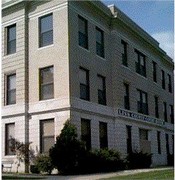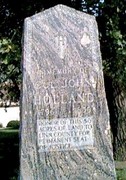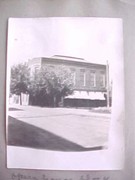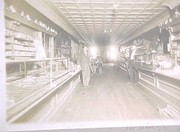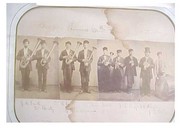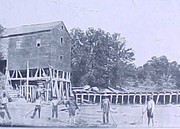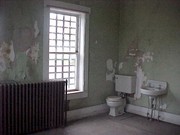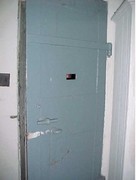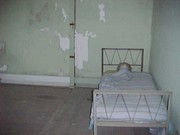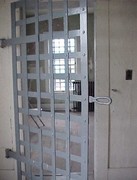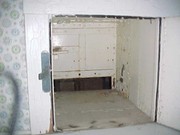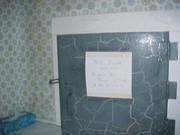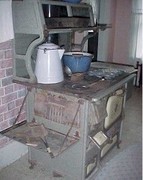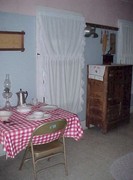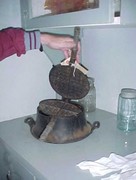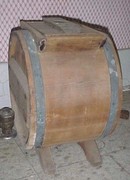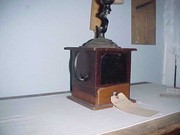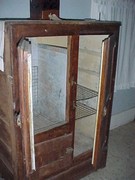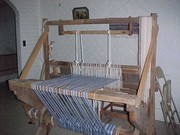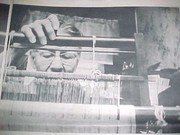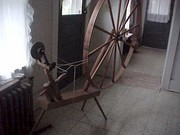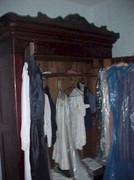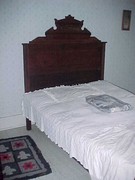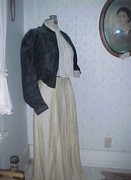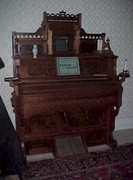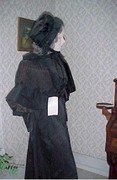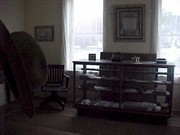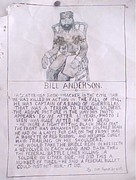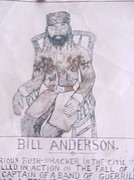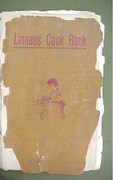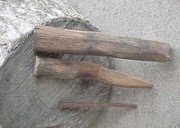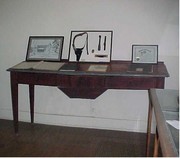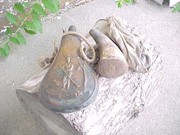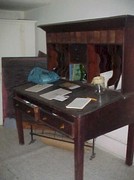Linneus History
Linneus, Missouri has had an interesting history from its first settlement in 1834 to its status as the county seat of Linn County today. Although the population of Linneus was only 481 at the 1990 census, it was once a bustling center of commerce, as seen in the late 1800's photo at the left. It is assumed that this is street that runs north and south, directly west of the courthouse, which would be High Street, today.
History
The first settler in Linneus was Colonel John Holland, who came from Virginia in the early spring of 1834 and located his claim approximately where the courthouse is now. Heavy timber (and timber wolves) surrounded the two-room cabin for many years.
After the cabin was built, Holland left his female slave Dinah in charge of 30 sheep and the premises until he returned from the East with his family and other slaves many weeks later. Therefore, the first female resident of Linneus was a black woman. She was freed upon his death in 1855, but remained in Linneus all her life. Her account of her experience alone with the wolves and sheep can be read in the History of Linn County.
In 1834, Linneus was made the county seat. Within 10 years there were approximately 100 residents. The city of Linneus was incorporated on February 9, 1853. Early school classes were held in the Holland cabin and were taught by his daughter Sallie. In 1847, the first public schoolhouse was built near where the railroad eventually ran. The nearest true doctor was Keytesville. However, Judge James A. Clark did most of the regular doctoring for the settlement although he had never had any medical training. Quinine and calomel were his main medicines. (Source: History of Linn County)
Photos
Believe it or not, Linneus (and many other small towns in the 1800's) featured an "opera house," which featured a stage and theater seating for traveling drama shows and local performances. The location of the Linneus Opera House is uncertain, but from the photo it appears to have been quite an establishment. Another prosperous business was the McMillan Hardware. You can also view a photo of the 1871 Brass Band in the slide show.
Jail and Museum
by Rick Thurlo (1999)
The former Linn County Jail is located in downtown Linneus on the corner of Highway 5 and Route B, just southeast of the Linn County Courthouse. The building is now a museum that is basically only open by appointment.
The building served as the Linn County Jail for about 100 years. The sheriff and his family were expected to reside in the jail building and take care of the prisoners. There were other staff members also available. The Linn County Court (now known as the Commissioners) agreed to building this building in 1869, right after the Civil War. The building was completed in 1871 and accepted as satisfactory by the county officials. The total cost was $9,000. I don't think $9,000 would build a jail today!
Many different sheriffs resided at and operated the jail over the century. I'm sure lots of improvements and changes were made during that period of time. One sheriff that has a connection to our school was Frank Hoskins. He is the great grandfather of several of the Hoskins family members in school, and grandfather of Rance Shifflett, husband of Linn County R-1 school nurse. Mrs. Hoskins had a reputation among the prisoners as being an excellent cook. Mr. Hoskins was later elected to other Linn County offices. He was a World War I veteran and I enjoyed listening to Mr. Hoskins and the grandfather discuss World War I.
The first sheriff that I can remember was Dewey Chapman, great-grandfather of Linn County R-1 student Heather Brinkley. My Chapman was a big tall man (to me) and put me in the mind of Matt Dillon of "Gunsmoke" fame. The last sheriff to reside at the jail was Jess Taylor. I remember when Mr. Taylor was elected in 1964. He was known for letting the "trusty" prisoners out to mow the park, sweep sidewalks, etc. Mr. Taylor had a good reputation for treating prisoners well.
I recall several escape stories, most of which were fairly harmless, although it definitely upset people for some time. Sheriff Taylor in the late 1960's insisted that the condition of the jail was unsafe for use. He wanted the officials to spend quite a bit of money to get the jail up to a reasonable level. As I recall, the outlook for repairing the jail didn't look promising, so Mr. Taylor announced the jail was closed. There was some discussion as to whether the sheriff could close the jail or not, but to the best of my memory it didn't reopen as a jail or a law enforcement office after Mr. Taylor's announcement.
Austin Mill
The Austin Mill was one of Linn County's first commercial businesses. It was established on Locust Creek west of Linneus in 1842, about five years before the establishment of the town of Linneus. The mail road from Linneus, the county seat of Linn County, to Trenton, the count seat of Grundy County, was laid out and built to pass by the site of this mill. The site of the mill isn't far from where the Route B bridge crosses Locust Creek today, but we must remember Locust Creek has been straightened and the present channel is not the original channel.
The mill got the name "Austin" because it was owned by a man named Austin in the 1870's and somehow the name stuck. Actually, there were several owners. The mill was originally established in 1842 by a man named Botts. Botts is a familiar name in the Linneus area; there is a Botts cemetery; there was a Botts school and at one time a Botts-Beavers 4-H Club, all in the general area. Mr. Botts was joined in the mill operation by a Mr. Bowyer. Boyer and Botts worked together and then each family actually owned the mill for some period of time. The mill was very popular and had a good reputation.
Mr. Bowyer and his descendents became very prominent in the area. There are many descendents of Mr. Bowyer in our area today, including Ken Jennings, husband of long-time Linn County R-1 teacher, Kay Jennings. Mr. Jennings' grandmother's maiden name was Bowyer.
The mill survived the Civil War and lasted many years after that. In the 1890's economic and social conditions changed and the mill proved not to be near as profitable. It fell into disrepair and began to fall apart. The owners were no longer making a profit, so in the mid 1890's the mill shut down for the final time and more or less disappeared into the creek and history.
It served the needs of the early settlers for ground corn and wheat and other grains to be used for flour, which were very important in each house. It also provided ground feed especially ground corn for livestock feed. The horses usually got along a lot better with ground grain.
Jail Interior
The jail basically consists of two large upstairs rooms, four downstairs rooms, a bath, kitchen, and cell area. The north room upstairs room was used as a cell. It was sparsely furnished with a toilet, basin, and single bed. The south upstairs room was used as part of the living quarters for the sheriff.
Prisoners were also held in a more secure southeast room on the ground floor. A cell, cage-like enclosure sat the middle of the interior of the room, to the right of the entry door. Right now, the room is filled with miscellaneous boxes filled with old hospital supplies. I'm not sure how these supplies came to be there. It is definitely dark and dreary. Food was passed through a two-foot square passage from the kitchen hallway on one side to the cell room on the other side.
Food was prepared by wife of the sheriff usually. The kitchen has been reconstructed with period furnishings, including a wood cooking stove, table, non-electric waffle iron, butter churn, coffee grinder, (donated by Ed Turner) and ice box.
The adjoining room to the west was probably used as a small bedroom. Today stores a loom, which had been owned by Ray and Anna Shouse. It had been made by Anna Shouse's great-grandfather, when he arrived in Missouri in the 1850's. Next to the loom is a 1984 copy of the Rural Missouri, which featured Mrs. Shouse as the cover story. In the same room is also a spinning wheel with a wheel that is at least three foot diameter.
Another room on the north side was probably used as another bedroom. Today it contains a walnut wardrobe donated by Marjorie Drake. Undoubtedly, a wardrobe similar to this was used for clothing because there are no closets in the entire structure. There is also a full-sized bed and a mannequin dressed period clothing, donated by Joseph Street. The cape was worn by his mother.
Two large rooms are in the front of the building. The north room today contains a large overstuffed "executive" chair, a foot-pump organ (donated by Allen Powell), Persian carpet, and mannequin dressed in clothing of the 1800's.
The southwest room contains glass display cases containing papers and other artifacts of the time period, including photographs. One interesting item is a hand-drawn "wanted poster" for Bill Anderson, who was a notorious bushwhacker during the Civil War. He was responsible for the "Centralia Massacre," during which approximately 150 soldiers and civilians were killed in ambushes; businesses were robbed, a train was set on fire, etc. This occurred September 27, 1864. Anderson was killed later in the year near the present town of Richmond, Missouri. He was embittered with the Union army because his wife and some other women had been incarcerated by the Union army in an attempt to discourage bushwhacking. While in jail in Kansas City, the jail collapsed killing his wife and others.
Other artifacts in this room include a turn of the century Linneus Cookbook, wooden nails and pegs taken from a community home, sheriff's artifacts, and a powder horn and leather pouch.
The front door opens into an entryway, which houses a large cubbyhole desk and entries to the cell room and upstairs staircase.



